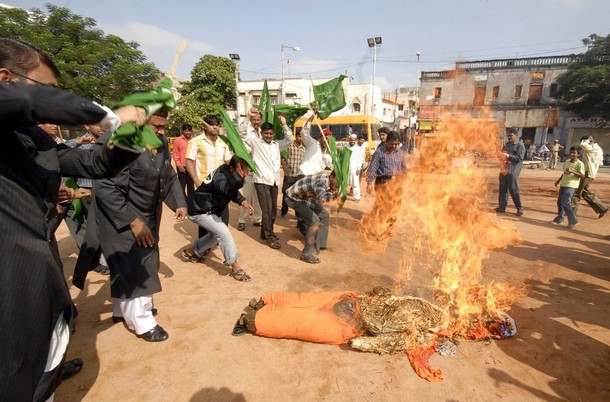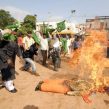
Hindu Radicals Pose Terrorist Challenge to the Sub-Continent
Publication: Terrorism Monitor Volume: 7 Issue: 3
By:

The charge sheet filed in a Mumbai court on January 20 against 11 members of the radical Hindu group Abhinav Bharat – including a serving Military Intelligence officer, a retired Indian Army Major, and nine other activists – has brought the growing landscape of Hindu terrorist cells in India into the open (The Hindu, January 21).
In the last decade a few radical Hindu groups have carried out systematic hate campaigns against minority communities, particularly India’s 150 million Muslims, including mob violence (as in Gujarat in 2002) and bombings (such as the 2004 blast in Nanded, Maharashtra). The September 29, 2008, Malegaon bomb attack in which the Hindu militants are charged was the first sophisticated bombing to be planned and executed by a Hindu terrorist group (Times of India, January 20).
Pursuing the Hindu Rashtra
The Malegaon bombing was intended to be the first of a series of attacks the group had planned throughout India to establish a “Hindu Rashtra,” or Hindu India. The 4,528-page charge sheet, citing 389 witnesses, accused Lieutenant Colonel Shrikant Prasad Purohit, retired Major Ramesh Upadhyay, self-styled religious preachers Sadhvi Pragnya Singh and Dayanand Pandey (a.k.a. Swami Amritanand), and others of executing a bomb blast in Malegaon, a Muslim-dominated city in Maharashtra, one of India’s prosperous west coast states. The bomb, strapped to a motorcycle, killed six persons and injured more than 70. The accused have been charged under the Maharashtra Control of Organized Crime Act (MCOCA), a tough law that has survived criticism while other severe laws fell after intense public scrutiny.
What really took the country and the Maharashtra Anti-Terrorism Squad (ATS) by surprise was the involvement of a serving military officer in a terrorist act. Lieutenant Colonel Purohit, ironically, had trained the ATS when it was formed in 2004 (India Today, January 20). Purohit is the first serving Indian Army officer to be formally charged with aiding and abetting terrorism since independence. Purohit surrendered to the investigating officer in the Malegaon case, Joint Commissioner Hemant Karkare, in October. Karkare was later killed by Muslim terrorists in the Mumbai terror attack of November 26, 2008.
Several serving and retired army officers were questioned after Purohit was detained (IBNLive [India], November 25, 2008). Investigators complained that the Indian Army stalled the progress of the investigation by not cooperating with them to find out how Purohit managed to forge documents used to obtain a fake identity card from the military cantonment at Deolali for bomb maker Sudhakar Chaturvedi. Purohit’s role in procuring a license for Chaturvedi’s revolver from the army quota also remains a mystery (Outlook Magazine, December 1, 2008). One of the officers later told police that he was misled into joining meetings of Abhinav Bharat in Faridabad and Kolkata after Purohit convinced him that it was a covert military intelligence operation (Indian Express, January 22).
The investigators were also keen to find out whether Purohit had access to explosives and weapons used for training and whether the Army had any knowledge about missing weapons and explosives from depots and other establishments where Purohit was stationed (Outlook Magazine, December 1, 2008).
Organizing the Abhinav Bharat Group
The charge sheet for the first hearing of the case on February 12 says Purohit set up Abhinav Bharat (Young India) in Pune (Maharashtra state) in June 2006 “with the intention of propagating a Hindu Rashtra with its own constitution and aims and objectives such as Bharat Swaraya, Surajya Suraksha (‘self-rule, good rule and security’)” (Frontline [India], January 31-February 13). Purohit borrowed the group’s name from another extremist group, one of whose members was involved in the assassination of Mahatma Gandhi (Indian Express, February 1, 2009). The older Abhinav Bharat organization was dissolved in 1952. The prosecution says the group’s ultimate agenda was to create a Taliban-like organization to promote its plans for a Hindu nation. The group had even worked out the design for a national flag – saffron in color, with a gold border.
Abhinav Bharat had plans to raise funds from top corporate houses like Tatas and Mahindras under the guise of a disaster management company (Times of India, January 26). The court says Purohit collected funds for himself and Abhinav Bharat to promote a "fundamentalist ideology." Though a chunk of the money was used by the group’s treasurer, Ajay Rahirkar, to procure explosives and other weapons, an advance was quietly paid to a builder in Nashik (Maharashtra) for a house for Purohit (Zee News [India], January 20; Samaylive.com, January 20).
The group also thought of approaching Israel for assistance but, according to ATS chief K.P. Raghuvanshi, there is no evidence such a contact was made. Raghuvanshi also indicated the possibility some of the suspects were in touch with Maoists in Nepal, but again there was no hard evidence to prove the link (The Hindu, January 21). Recordings of a meeting which Purohit and others attended in Faridabad (Haryana state) in January 2008, point to at least two operations carried out by the group prior to Malegaon. Evidence has raised the possibility of the group’s involvement in the February 2007 bombing of the Samjhauta Express and twin blasts in Hyderabad in May, 2007 (Indian Express, November 17, 2008; January 24, 2009; Rediff.com, November 15, 2008)
The charges claim the group held meetings at various places – Ahmedabad, Ujjain, Bhopal, Kolkata, Jabalpur, Indore, Faridabad, and Pune – where Purohit and his associates absorbed men from diverse backgrounds to their cause while sketching plans for terrorist attacks. The unifying theme of their discussions was their belief that the future of Hindus in India was in jeopardy (The Hindu, January 21). There is also evidence the group was planning to bring out Hindu extremist literature on the model of Muslim jihadi literature. A laptop seized from one of the accused revealed a cache of jihadi publications (Sakaal Times, January 23).
Purohit’s plan was to utilize the infrastructure used by a national youth organization, the Bharat Scouts and Guides, to train the recruits. The group had even bought land in Maharashtra to set up a training camp (Times of India, January 26). After training, the recruits were to be employed in security agencies.
The Malegaon bombing was planned in January 2008. According to the court, the group decided to bomb Muslim-dominated Malegaon because, Purohit said, “There is a huge population of Muslims in Malegaon. If something is done in Malegaon, it would be like avenging the atrocities against the Hindus.” There were two other reasons for choosing Malegaon – first, September was the month of Ramadan and mosques would have large Muslim gatherings to offer prayers. Second, the group thought it would be easy to mislead the investigating agencies since a jihadi group, the Students Islamic Movement of India (SIMI), had carried out a bombing in Malegaon in 2006 (The Hindu, January 21).
The Sri Ram Sene Organization
Sri Ram Sene is another Hindu extremist group that has been indulging in violence against minority communities in Karnataka state. Pramod Muthalik Desain, generally regarded as a fanatic rabble-rouser, set up Sena in 2004 after he fell out with Bajrang Dal, an extremist group that once had a fairly strong presence across the country but had lost its appeal due to infighting and a police crackdown on its activities.
The Sene, with a membership of 2000, mostly 18 to 25 year olds, many of them unemployed, has been following an agenda aimed at preserving the Hindu culture by opposing fashion shows, women drinking in public places, inter-religious and extra-marital relationships, and fundamentalism in other communities (Indian Express, February 1). The Sene members work in tandem with other extremist groups like Bajrang Dal and Hindu Jagaran Vedike. A gang of Sri Ram Sene hooligans recently thrashed young men and women at a pub in Mangalore. Pramod Muthalik Desai and 28 others charged in the attack were released on bail at the end of January, only to turn around and threaten anyone found celebrating Valentine’s Day, an expression of “anti-Indian culture” (IBN Live, February 3; Economic Times, January 31).
Pramod Muthalik Desai met Colonel Purohit at least once in Kolkata (February 2008) to discuss the Abhinav Bharat’s plans. The Kolkata meeting was organized by another radical named Tapan Ghosh, who ran a little-known militant group called Hindu Samhati (India Today, January 28).
Related Groups
Another link in the chain of Hindu extremism has been the involvement of a former Member of Parliament in militant activites. According to police, MP BL Sharma attended a meeting of Abhinav Bharat in September 2007 at Nashik, where plans for a series of terrorist attacks were discussed (Times of India, February 3). Sharma was a member of Vishwa Hindu Parishad (VHP), the parent body of the Bajrang Dal militant group. The VHP acquired considerable strength and acceptability in Indian society after it took the lead in demolishing the Babri mosque in Ayodhya (Uttar Pradesh) in December 1992. VHP leader Praveen Togadia denies reports he met with Pramod Muthlalik at a Mumbai hotel on August 1, 2008 (Outlook Magazine, December 1, 2008; Times of India, November 24, 2008). Another connection has developed with Nagaraj Jambagi, a close associate of the Sri Ram Sene leader who was recently arrested by Karnataka police in connection with the May 2008 Hubli blasts (Tehelka News Magazine, February 7).
Police officers investigating different violent incidents involving these groups believe that many of them had set up training camps in several parts of Maharashtra, Adilabad in Andhra Pradesh, northern Karnataka, and also in parts of Gujarat (Rediff.com, November 10, 2008). Sri Ram Sene runs one such camp, though Muthalik maintains that the camp was not a terrorist training camp but focused on training “Anti-Terror Squads” (Rediff.com, November 10, 2008).
Conclusion
What is worrisome is that groups like Abhinav Bharat will increasingly draw support from some influential and resourceful sections of the Hindu community as a counter-response to Islamic groups like the Indian Mujahideen (IM), which has already shown a tendency to exploit the communal divide in the country. If not countered adequately and in time, these early symptoms of a cycle of violent religious hatred could seriously test India’s efforts to counter multi-dimensional terrorist threats without damaging the pluralist fabric of its society.




